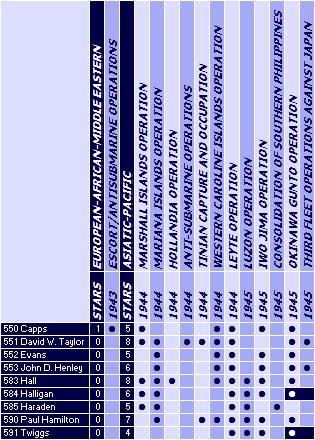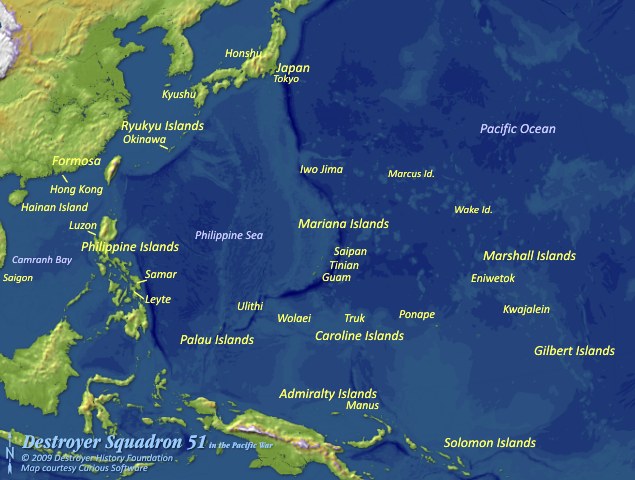Destroyer Squadron 51
1943
Destroyer Division 101
USS Hall (DD 583), flag
USS Halligan (DD 584)
USS Haraden (DD 585)
USS Paul Hamilton (DD 586)
USS Twiggs (DD 587)
Destroyer Division 102
USS
Capps (DD 550)
USS
David W. Taylor (DD 551)
USS Evans (DD 552)
USS
John D. Henley (DD 553)
Destroyer Squadron 51 in World War II was a squadron whose
2,100-ton Fletcher-class destroyers were deployed in thirteen diverse operations in both the Atlantic and Pacific. The nine ships came from three yards as follows:
- Capps (DD 550), David W. Taylor (DD 551), Evans (DD 552) and John D. Henley (DD 553), the first four 2,100-tonners built by Gulf Shipbuilding—round-bridge ships commissioned over an extended period between June 1943 and February 1944.
- Hall (DD 583), Halligan (DD 584), Haraden (DD 585), a square-bridge trio from Boston Navy Yard commissioned in July, August and September 1943.
- Paul Hamilton (DD 590) and Twiggs (DD 591) square-bridge ships from Charleston Navy Yard commissioned in October and November 1943.
Destroyer Squadron 51
World War II Operations

OPERATIONS
Capps, the first to commission, was (with
Jenkins) one of only two 2,100-tonners to earn an engagement star for service in the Atlantic: from September through November 1943, she operated from Scapa Flow with USS
Ranger (CV 4) and the British Home Fleet in missions as far north as Norway and as far south as Gibraltar.
Twiggs also operated in the Atlantic early in her career, from Norfolk as a training ship until May 1944.
Beginning in December 1943, all other DesRon 51 ships began making their way to the Pacific, some in time for the Marshall Islands operation, continuing in various combinations through the Marianas operation, where Haraden was damaged in a bomb attack, and Palau.
For the Leyte landings in October 1944, all nine ships operated with the Third Fleet’s Logistic Group. At the end of the year, DesDiv 101 continued on to Luzon, where Haraden was again damaged while escorting a carrier task force in the Sulu Sea and again returned to the West Coast for repairs. David W. Taylor, attached to a task force striking the Bonin Islands meanwhile, sustained an underwater explosion, probably a mine, and also went home.
In 1945, the seven ships remaining in the war zone participated in the Iwo Jima operation. David W. Taylor returned to join them in time for Okinawa, after which she and John D. Henley closed out the war with the Third Fleet off Japan while the other surviving ships of the squadron returned home.
LOSSES
- On 26 March, 1945, Halligan was mined at Tokashiki Jima, Okinawa with a loss of 160 killed and 43 wounded of a crew of 327 officers and men.
- On 16 June 1945, Twiggs was torpedoed and then crashed by a single suicide plane off Okinawa with a loss of 152 killed of a crew of 340.
DECORATIONS
Evans received the Presidential Unit Citation for her action with
Hugh W. Hadley off Okinawa on 15 May 1945. Severely damaged, she was not repaired following the war.


